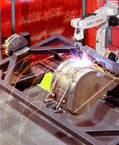 In the manufacturing industry, worker safety has long been one of the biggest concerns of employers. Manufacturers have worked long and hard to overcome the public perception of manufacturing as a dangerous field of work.
In the manufacturing industry, worker safety has long been one of the biggest concerns of employers. Manufacturers have worked long and hard to overcome the public perception of manufacturing as a dangerous field of work.
Of course, the notion that manufacturing jobs can be hazardous is not completely unfounded. In the past, on the job injuries were common among manufacturing industry workers. A century ago, it was common for workers to toil away for hours doing hard, repetitive tasks that were dull and exhausting. Exhausted, tired laborers became prone to making mistakes, causing accidents, many of which caused permanent injury.
Even as recently as the 1990s, injuries among the employees at Marlin Steel were fairly commonplace. Workers were making bends, cuts and welds in wire forms by hand. The labor was repetitive and physically demanding, lowering alertness and the ability to respond quickly when necessary.
Fatigued workers combined with a plentiful supply of power tools and sharp, small pieces of metal proved to be a ready-made recipe for disaster. Injuries plagued the manufacturing floor, some of them severe. In fact, at one point, there was a major safety incident as often as four times per year. Workman’s comp costs were through the roof, and production slowed every time there was an incident.
Clearly, something had to be done to improve the safety of the manufacturing process. The real question was: “how?”
At the same time, Marlin Steel’s owners were faced with another challenge: maintaining market share when foreign competitors were selling the same commodity baskets for less than the cost of the steel.
Improving Safety
As luck would have it, there was a way to meet both goals at the same time: by investing in manufacturing automation.
By making the switch to automated manufacturing processes, Marlin Steel’s workers were able to craft parts with a margin of error much smaller than was previously possible. This improved level of precision opened up new markets beyond the simple bagel baskets that Marlin Steel was once known for.
With the machines doing most of the heavy lifting, Marlin’s workers quickly found that they were not suffering from fatigue the way that they once did. In addition, workers didn’t have to handle sharp parts and potentially dangerous equipment by hand, limiting their exposure to injury.
Now, if a weld sends off an unexpected spark, the worker overseeing the welding machine’s operation is well away from it, largely eliminating the possibility of injury. With human workers being able to stand back and monitor the assembly of intricate parts rather than having to be up close to the process, safety is greatly improved.
“How improved,” you ask?
Thanks to the adoption of automation, the Marlin Steel production floor has gone more than 2,000 days without incident. That’s almost five and a half years without any kind of injury. Previously, the accident rate was once one incident every 91 days. This means that since the adoption of automated manufacturing techniques, the accident rate is 4.5 percent of what it used to be (and shrinking).
By combining manufacturing automation with a dedicated safety effort, manufacturing jobs can be made safer than ever before throughout the entire industry.

.gif)


